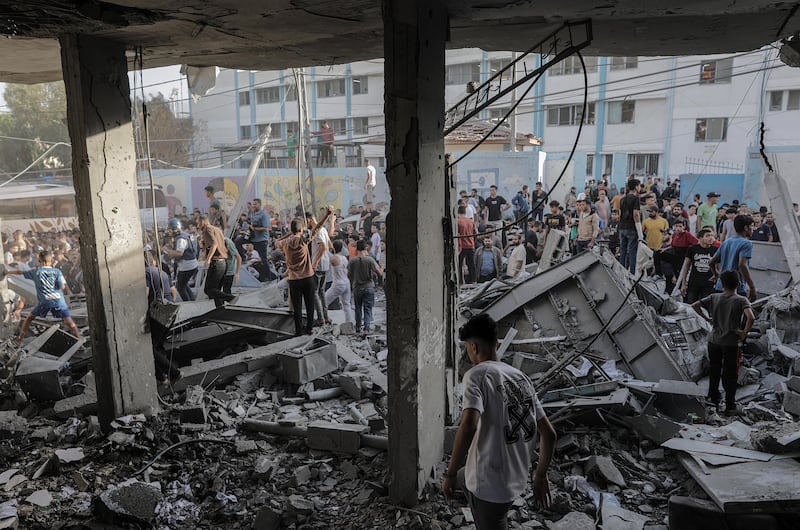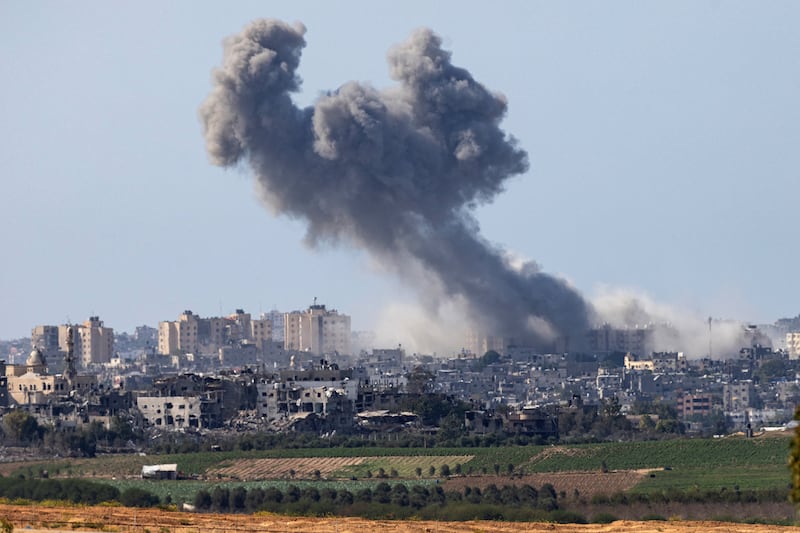Twenty trucks carrying aid crossed into Gaza on Saturday, the first convoy of humanitarian supplies since Israel began a devastating siege 12 days ago and after further heavy Israeli bombardment overnight that killed dozens of Palestinians.
US president Joe Biden had said earlier this week that agreement had been reached for the aid trucks to enter via southern Gaza Strip’s Rafah border point with Egypt.
The flatbed trucks, flying white flags and honking their horns, exited the crossing after checks and headed into Gaza’s southern area which includes the major towns of Rafah and Khan Younis where hundreds of thousands of people made homeless by Israel’s unrelenting air war are sheltering.
However, Palestinian officials were disappointed that fuel supplies were not included in the consignment of food, water and medical supplies and added that the aid was only three per cent of what used to get into Gaza before the crisis.
READ MORE
[ Thousands march through Dublin in support of Palestine amid conflict in GazaOpens in new window ]
“Excluding the fuel from the humanitarian aid means the lives of patients and injured will remain at risk. Gaza hospitals are running out of the basic requirements to pursue medical interventions,” the Gaza health ministry said.
Israel’s “total siege” of Gaza, launched after the October 7th cross-border attack on southern Israel by militants of the Islamist movement Hamas, has left the enclave’s 2.3 million people running out of food, water, medicines and fuel.
The United Nations said the convoy included life-saving supplies would be received and distributed by the Palestinian Red Crescent, with the consent of Hamas, which rules Gaza.
US secretary of state Antony Blinken welcomed the opening but echoed a warning from Israel that no aid should end up in Hamas hands.
“We urge all parties to keep the Rafah crossing open to enable the continued movement of aid that is imperative to the welfare of the people of Gaza,” Mr Blinken said in a statement.
“We have been clear: Hamas must not interfere with the provision of this life-saving assistance.”
UN officials say at least 100 trucks daily are needed and that any aid operation must be sustainable at scale – a tall order now with Israel carrying out bombardments day and night that have wrecked entire populated districts.

Before the outbreak of conflict, an average of about 450 aid trucks were arriving daily in Gaza.
Diplomacy to secure a ceasefire has been fruitless so far.
Arab leaders at a hastily convened Cairo summit on Saturday condemned Israeli bombardment of Gaza as Europeans said civilians should be shielded, but with Israel and senior US officials absent there was no agreement on containing the violence.
Israel had kept up air strikes on targets around Gaza in Saturday’s early hours after prime minister Binyamin Netanyahu vowed to “fight until victory” following the release of the first two hostages by Hamas.
Hamas on Friday freed Americans Judith Tai Raanan (59) and her daughter Natalie (17) who were among around 210 kidnapped in the assault on southern Israel by Hamas this month. Hamas said it acted in part “for humanitarian reasons” in response to Qatari mediation.
However, Hamas said on Saturday it would not discuss the fate of Israeli army captives until Israel ends its “aggression” on the Gaza Strip, one of the world's most densely populated places.
Hamas gunmen seized the hostages when they burst out of the blockaded enclave into Israel and killed 1,400 people, mainly civilians, in a shock rampage, the deadliest single attack on Israelis since the country's founding 75 years ago.
Gaza’s health ministry said on Saturday Israel’s air and missile strikes had killed at least 4,385 Palestinians, including hundreds of children, while over a million of the territory’s people have been displaced.
Israel has amassed tanks and troops near the fenced border around the narrow coastal enclave for a planned ground invasion with the objective of annihilating Hamas, after several inconclusive wars dating to its seizure of power there in 2007.
Israeli troops have carried out live fire drills “in preparations for the next stage of war”, footage released by the Israeli army on Saturday showed.
Overnight on Saturday, Israeli fighter jets struck a “large number of Hamas terror targets throughout” Gaza including command centres and combat positions inside multistorey buildings, the military said in a statement.
Gaza’s health ministry and Hamas media said Israeli aircraft had overnight targeted several family houses across Gaza, killing at least 50 people and injuring dozens.
Hamas said it fired rockets towards Israeli's biggest city Tel Aviv on Saturday in response to those deaths. The Israeli military reported a fresh salvo of rockets from Gaza against southern Israeli border communities before dawn.

A senior Israeli military official who declined to be named said Israel had killed “a few thousand” Hamas militants in the war.
“It is not enough. We need to take more ... We are looking at a long campaign. They are already hurting, but there is still some way to go,” he said.
He also said the air force had targeted some militants in their own homes, and acknowledged that civilians living nearby might have been hurt.
Most of Gaza's inhabitants depend on humanitarian aid. The heavily urbanised and widely impoverished territory has been under Israeli and Egyptian blockade since Israel unilaterally withdrew from the enclave in 2005.
Israel has told all civilians to evacuate the northern half of Gaza, which includes Gaza City. Many people have yet to leave saying they fear losing everything and have nowhere safe to go given that southern areas have also been bombarded.
Some said the aid arriving on Saturday was too little to make a difference.
“This is a drop in the ocean. You are trying to show the world that you are bringing aid. This is throwing dust in the eyes,” said Nabil El-Dhaba, a resident of the Shejaia district in Gaza City who has been displaced to Deir Al-Balah in the southern Gaza Strip. – Reuters
(c) Copyright Thomson Reuters 2023














